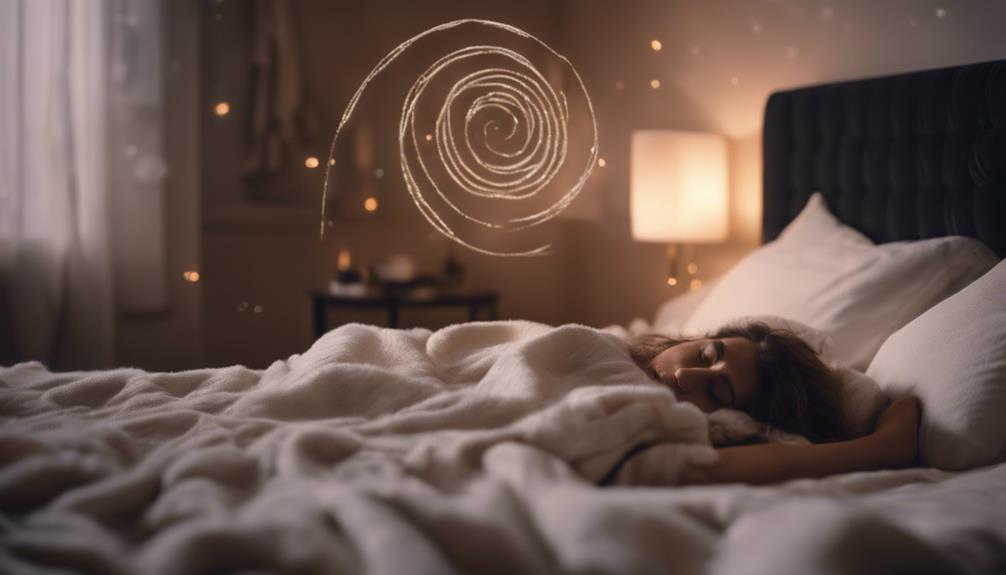
Harness the power of hypnosis through techniques like guided visualization, deep breathing, progressive muscle relaxation, positive affirmations, and hypnosis apps for sleep anxiety. Create a calming bedtime routine with aromatherapy, stretches, and white noise machines. Monitor progress, identify triggers, and adjust strategies to optimize hypnosis benefits.
These evidence-based methods offer a holistic approach to address sleep anxiety and enhance restorative sleep quality. Discover a range of practical and effective ways to incorporate hypnosis into your bedtime routine for improved sleep and reduced anxiety.
Key Takeaways
- Use hypnosis for sleep anxiety by engaging in guided visualization techniques.
- Practice breathing exercises and techniques during hypnosis for stress relief.
- Incorporate progressive muscle relaxation in hypnosis sessions for physical and mental relaxation.
- Integrate positive affirmations and self-hypnosis to promote relaxation before sleep.
- Utilize hypnosis apps, audio tracks, and virtual sessions for structured sleep improvement techniques.
Understanding Sleep Anxiety
Understanding the complexities of sleep anxiety is crucial in order to effectively address and alleviate its impact on individuals’ quality of rest. Sleep anxiety can disrupt normal sleep patterns, leading to difficulties falling asleep, staying asleep, or experiencing restful sleep.
Cognitive therapy has emerged as a promising approach in managing sleep anxiety. By targeting negative thought patterns and beliefs that contribute to anxiety around sleep, cognitive therapy helps individuals reframe their thoughts and develop healthier sleep habits. This therapy focuses on identifying and challenging irrational beliefs about sleep, replacing them with more realistic and positive thoughts to promote better sleep quality.
Research has shown that cognitive therapy can be effective in improving sleep outcomes for individuals struggling with sleep anxiety. By addressing the underlying cognitive factors that fuel anxiety, individuals can experience reduced anxiety levels, improved sleep patterns, and an overall enhancement in their quality of rest. This evidence-based approach offers a valuable tool in the thorough management of sleep anxiety.
Guided Visualization Techniques

Utilizing guided visualization techniques can be a powerful tool in managing sleep anxiety.
By engaging the imagination for relaxation, individuals can create positive mental images to counteract anxious thoughts.
These calming inner scenes can help promote a sense of peace and tranquility conducive to a restful night’s sleep.
Imagination for Relaxation
One effective method for managing sleep anxiety is through practicing guided visualization techniques, utilizing the power of imagination to induce relaxation and calmness.
Creative visualization involves picturing a peaceful scene or scenario in your mind, focusing on the details to create a vivid mental image that promotes a sense of tranquility. By engaging in relaxation techniques such as deep breathing while visualizing these calming scenes, you can effectively reduce stress and anxiety levels, making it easier to drift off to sleep.
Guided visualization techniques tap into the mind-body connection, allowing individuals to harness the therapeutic benefits of their imagination. Through this process, you can create a mental sanctuary where worries and tensions melt away, paving the way for a restful night’s sleep.
Positive Mental Images
Engage in guided visualization techniques to cultivate positive mental images that promote relaxation and alleviate sleep anxiety. Sleep visualization allows you to create a calming mental environment conducive to a restful night’s sleep. Positive imagery can help shift your focus away from worries and fears, allowing your mind to relax and prepare for rest.
Here are some ways to incorporate positive mental images into your bedtime routine:
- Create a Peaceful Scene: Imagine yourself in a serene setting like a tranquil beach or a quiet forest.
- Visualize a Stress-Free Bedtime Routine: Picture yourself going through a calming pre-sleep routine to signal to your mind that it’s time to unwind.
- Focus on Deep Breathing: Envision each breath as a wave of relaxation flowing through your body.
- Imagine a Blanket of Comfort: Picture a warm, cozy blanket of comfort enveloping you, providing a sense of security.
- Visualize a Peaceful Night’s Sleep: Picture yourself sleeping soundly, feeling safe and at ease, allowing your body and mind to rejuvenate.
Calming Inner Scenes
Incorporating calming inner scenes through guided visualization techniques can be a powerful tool in managing sleep anxiety and promoting relaxation before bedtime. Visualization benefits are rooted in the concept that the mind can influence the body, allowing individuals to create a mental oasis that promotes a sense of peace and tranquility.
By engaging in mental imagery techniques, individuals can transport themselves to serene environments like a peaceful beach at sunset or a tranquil forest clearing, helping to shift focus away from anxious thoughts and towards a state of calmness.
Research suggests that visualization techniques can decrease cortisol levels, reduce heart rate, and induce a state of deep relaxation, all of which are conducive to falling asleep more easily. This practice can also help individuals create a bedtime routine that signals to the brain that it is time to unwind and prepare for sleep.
Deep Breathing Exercises

Deep breathing exercises are a fundamental tool in managing sleep anxiety.
By focusing on breathing techniques, individuals can engage in calming mindfulness exercises that promote relaxation.
These practices can help quiet the mind and alleviate the stress and worries that often disrupt sleep.
Breathing Techniques
Utilizing controlled breathing techniques can be an effective method to alleviate sleep anxiety and promote relaxation. Breathing techniques for stress relief involve intentional regulation of breathing patterns to calm the mind and body.
Mindful breathing exercises encourage focusing on the present moment, enhancing awareness and reducing stress levels.
Here are some key breathing techniques that can aid in managing sleep anxiety:
- Diaphragmatic Breathing: Involves deep inhalation through the nose, allowing the belly to rise, followed by slow exhalation through the mouth to release tension.
- 4-7-8 Technique: Inhale quietly through the nose for a count of 4, hold the breath for 7 seconds, then exhale audibly through the mouth for 8 seconds.
- Box Breathing: Inhale for a count of 4, hold for 4, exhale for 4, and hold empty for 4, forming a ‘box’ pattern.
- Alternate Nostril Breathing: Involves closing one nostril while inhaling, then switching to exhale through the other nostril, promoting balance and relaxation.
- Equal Breathing: Inhale and exhale for an equal count, promoting a balanced breathing pattern and calming effect.
Calming Mindfulness Exercises
Implementing calming mindfulness exercises that include deep breathing techniques can greatly aid in reducing sleep anxiety and promoting relaxation. Mindfulness activities are powerful tools for stress management and sleep support. Deep breathing exercises are a fundamental aspect of mindfulness practices, helping individuals focus on their breath to calm the mind and body. By incorporating relaxation techniques into a bedtime routine, individuals can signal to their bodies that it is time to unwind and prepare for sleep.
During deep breathing exercises, individuals are encouraged to take slow, deep breaths in through their nose, hold for a moment, and then exhale slowly through their mouth. This intentional breathing pattern activates the body’s relaxation response, reducing heart rate and promoting a sense of calm. Practicing deep breathing regularly can train the body to relax more easily, making it a valuable tool for managing sleep anxiety and improving overall sleep quality.
Incorporating mindfulness activities and deep breathing exercises into daily routines can have a profound impact on sleep and overall well-being. By dedicating time to these practices, individuals can cultivate a sense of inner peace and enhance their ability to manage stress effectively.
Progressive Muscle Relaxation

One effective technique for addressing sleep anxiety through hypnosis is by incorporating progressive muscle relaxation. This method involves tensing and then releasing different muscle groups in the body to promote physical and mental relaxation. By combining hypnosis with progressive muscle relaxation, individuals can experience a deep sense of calmness and reduce the symptoms of sleep anxiety.
- Benefits of Progressive Muscle Relaxation:
- Helps release physical tension and promote relaxation.
- Encourages a mind-body connection for improved well-being.
- Enhances awareness of bodily sensations through a hypnotic body scan.
- Triggers the relaxation response in the body, aiding in stress reduction.
- Complements visualization techniques for effective sleep anxiety relief.
Positive Affirmations for Sleep

Positive affirmations can be powerful tools in promoting relaxation and calmness before sleep. By incorporating affirmations for relaxation, individuals can ease their minds and bodies, facilitating a smoother shift into sleep.
Similarly, affirmations for calmness can help reduce anxiety and create a more peaceful bedtime routine.
Affirmations for Relaxation
Incorporating affirmations for relaxation into your bedtime routine can effectively calm your mind and body, promoting a restful night’s sleep. Positive affirmations have shown great effectiveness in reducing sleep anxiety and aiding in relaxation. When combined with relaxation techniques and sleep hypnosis, affirmations can enhance their benefits further.
Here are some affirmations for relaxation that you can include in your nightly routine:
- ‘I release all tension from my body and mind.’
- ‘Every breath I take fills me with peace and tranquility.’
- ‘I am safe, and I allow myself to drift into a deep, restful sleep.’
- ‘My mind is clear, and I let go of all worries before bedtime.’
- ‘As I lay down, I invite calmness and relaxation to surround me.’
Affirmations for Calmness
Utilizing affirmations for calmness can greatly contribute to alleviating sleep anxiety and fostering a peaceful bedtime routine. Sleep mantras, such as ‘I am safe, I am calm, I am at peace,’ can help shift your mindset towards relaxation and tranquility before sleep. These positive affirmations work by redirecting your focus from worries and stress to soothing thoughts, preparing your mind for a restful night’s sleep.
In addition to sleep mantras, integrating relaxing visualizations into your bedtime routine can enhance the effectiveness of affirmations for calmness. Picture yourself in a serene setting, like a peaceful beach or a tranquil forest, allowing your mind to unwind and release tension.
Visualization techniques combined with positive affirmations can create a powerful synergy that promotes deep relaxation and helps ease sleep anxiety.
Self-Hypnosis Scripts
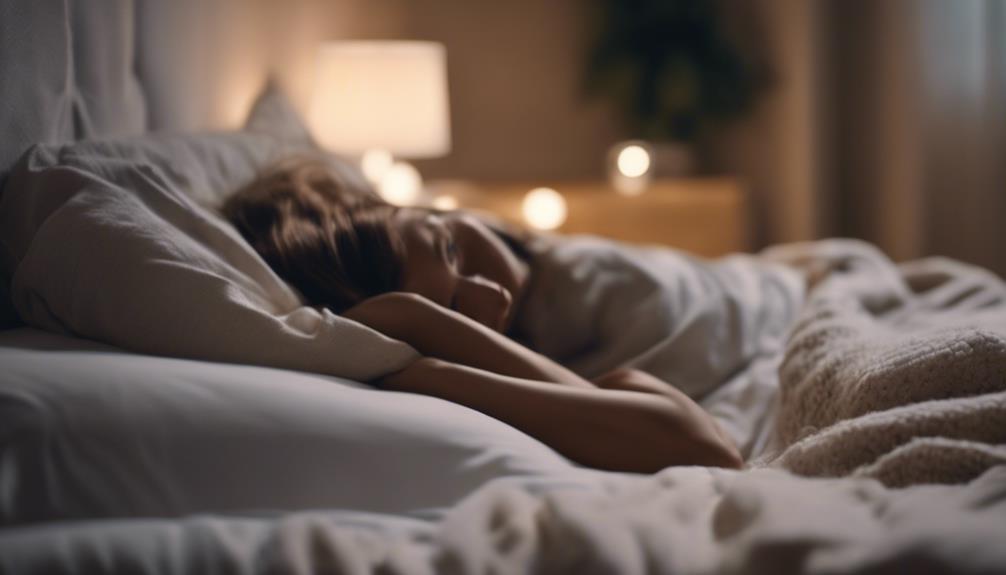
Creating personalized self-hypnosis scripts can be a powerful tool for individuals seeking to alleviate sleep anxiety and improve their overall quality of rest. By tailoring scripts to address specific concerns, individuals can harness the benefits of hypnosis for sleep improvement effectively.
Here are some key points to bear in mind when creating self-hypnosis scripts:
- Identify Specific Goals: Clearly define the sleep-related issues you want to address through self-hypnosis.
- Use Positive Language: Incorporate affirmations and suggestions that promote relaxation and a sense of calm.
- Visualize Relaxing Scenes: Guide yourself through mental imagery of peaceful settings to enhance the hypnotic experience.
- Include Progressive Muscle Relaxation: Integrate instructions to systematically relax muscles, promoting physical and mental relaxation.
- Repetition and Consistency: Repeat key phrases and concepts in your script to reinforce positive associations and maintain a consistent practice.
Crafting personalized self-hypnosis scripts tailored to your needs can enhance the effectiveness of using hypnosis for sleep anxiety management and overall well-being.
Hypnosis Apps and Audio Tracks
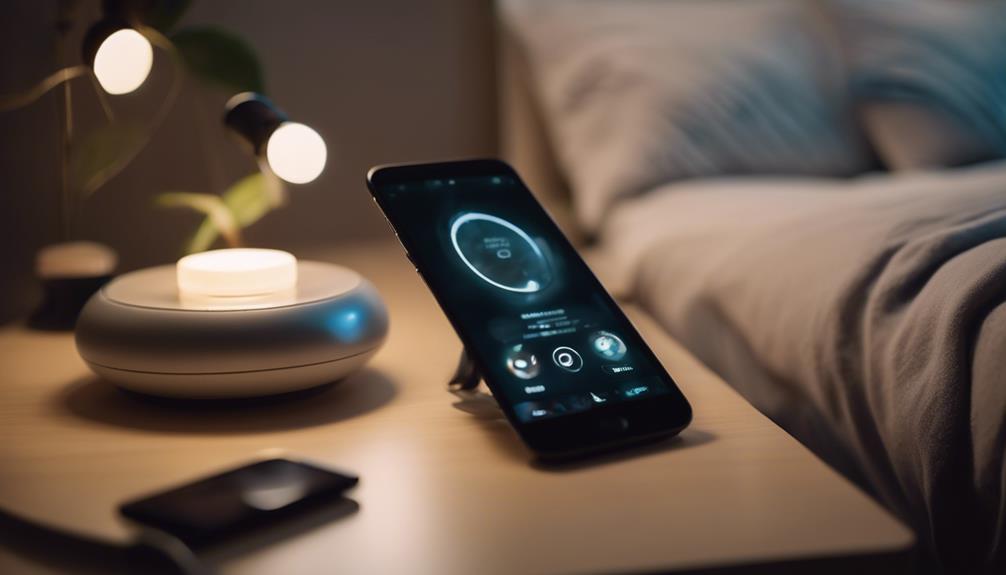
For individuals seeking convenient and accessible ways to engage in hypnosis for managing sleep anxiety, exploring hypnosis apps and audio tracks can offer valuable support. These resources provide a structured approach to using hypnosis techniques aimed at sleep improvement. Hypnosis apps often feature a variety of guided sessions tailored to address specific concerns related to sleep anxiety.
These sessions typically incorporate relaxation techniques, visualization exercises, and positive affirmations to help calm the mind and promote restful sleep.
Audio tracks designed for sleep anxiety often leverage soothing music or sounds combined with hypnotic suggestions to induce a state of deep relaxation conducive to sleep. Listening to these tracks before bedtime can help individuals unwind, alleviate anxiety, and prepare the mind for a peaceful night’s rest.
Additionally, the convenience of accessing hypnosis apps and audio tracks from the comfort of one’s own home makes them a practical and effective tool for managing sleep anxiety. By consistently incorporating these resources into a bedtime routine, individuals can harness the power of hypnosis for better sleep and overall well-being.
Virtual Hypnotherapy Sessions
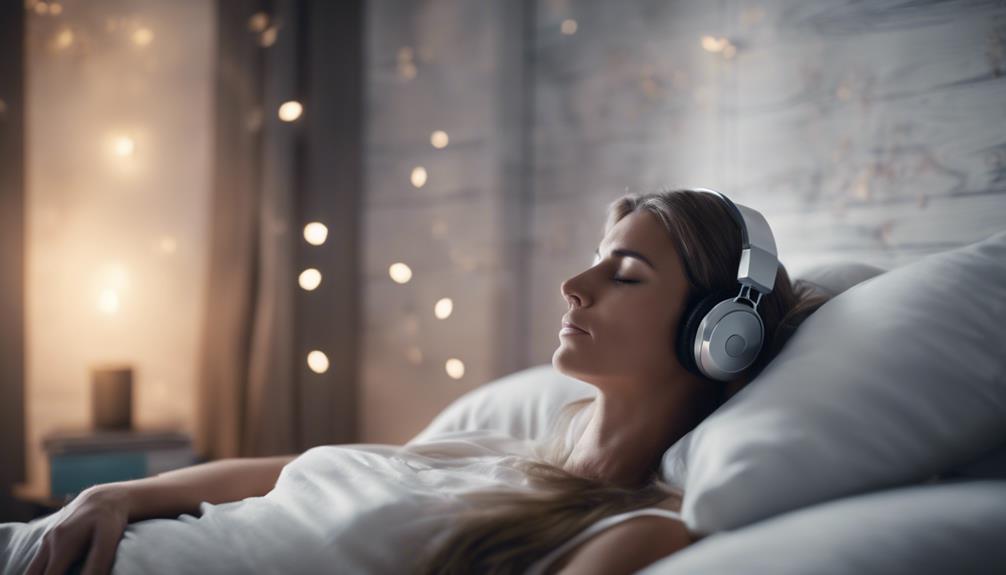
Amid the growing demand for remote mental health services, virtual hypnotherapy sessions have emerged as a convenient and effective option for individuals seeking support in managing sleep anxiety. These online sessions offer the benefits of traditional face-to-face hypnotherapy while providing the flexibility to engage in therapy from the comfort of one’s own home.
Virtual hypnotherapy sessions can be a powerful tool in addressing sleep anxiety by utilizing various sleep therapy techniques tailored to individual needs.
- Convenience: Access therapy sessions from anywhere with an internet connection.
- Privacy: Engage in therapy without concerns about physical presence or judgment.
- Personalization: Receive customized hypnotherapy sessions to target specific sleep anxiety triggers.
- Consistency: Regular virtual sessions help establish a routine for better sleep hygiene.
- Effectiveness: Evidence-based hypnosis benefits can be maximized through virtual platforms, promoting relaxation and alleviating sleep-related stress.
Creating a Relaxing Bedtime Routine
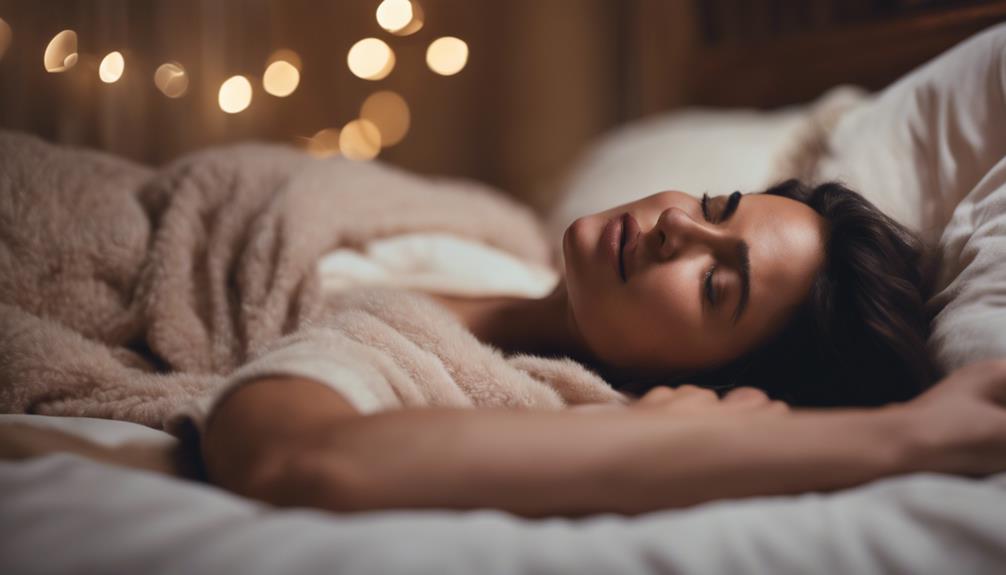
In establishing a restful environment conducive to better sleep quality, incorporating a soothing bedtime routine can greatly aid in reducing sleep anxiety and improving overall sleep patterns.
Aromatherapy benefits can be harnessed by using essential oils like lavender or chamomile, known for their calming properties, to create a relaxing atmosphere. Moreover, following sleep hygiene tips such as maintaining a consistent sleep schedule, avoiding caffeine and screens before bedtime, and keeping the bedroom cool and dark can contribute to a more peaceful night’s rest.
Engaging in bedtime stretches can help release tension from the body, promoting relaxation before sleep. Simple stretches like gentle yoga poses or progressive muscle relaxation techniques can be incorporated into the routine.
Additionally, utilizing white noise machines can drown out disruptive sounds and create a steady ambient noise that lulls the mind into a tranquil state conducive to falling asleep. By integrating these practices into a bedtime routine, individuals can enhance their sleep quality and reduce feelings of anxiety surrounding sleep.
Monitoring and Adjusting Progress
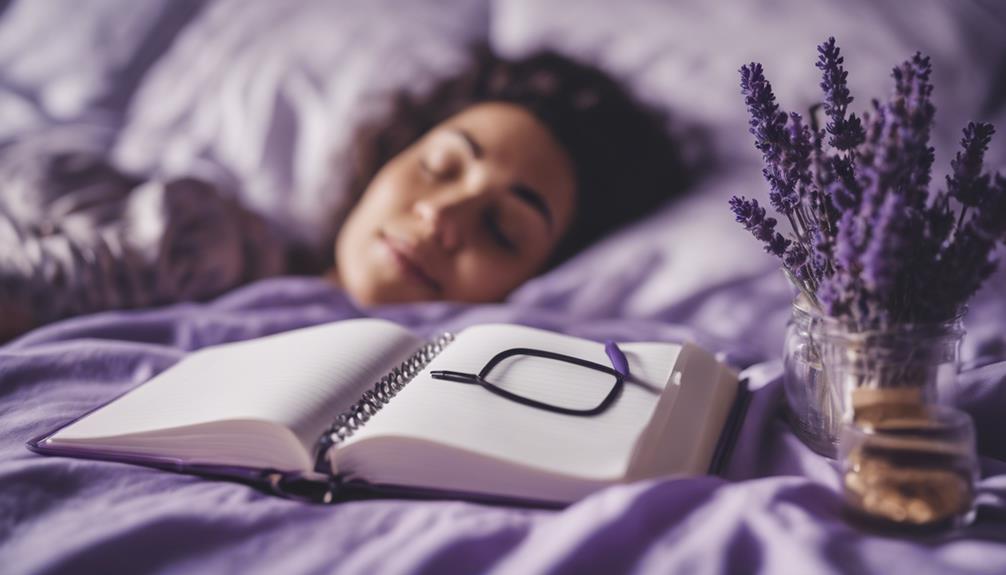
Tracking and making necessary modifications to one’s sleep patterns and anxiety levels is essential in effectively managing sleep anxiety using hypnosis. To monitor progress and make adjustments, consider implementing the following strategies:
- Sleep journaling: Keep a detailed record of your sleep patterns, including bedtime, wake time, and any disturbances during the night.
- Meditation tracking: Note your meditation sessions, duration, and how they impact your overall sense of calmness and relaxation.
- Dream analysis: Pay attention to your dreams and any recurring themes or emotions, as they can provide insights into your subconscious worries.
- Relaxation techniques: Experiment with various relaxation methods such as deep breathing, progressive muscle relaxation, or guided imagery to find what works best for you.
Regularly reviewing these aspects can help you identify patterns, triggers, and progress in managing your sleep anxiety through hypnosis.
Remember to adjust your approach based on the feedback you gather to optimize the benefits of hypnosis for better sleep and reduced anxiety.
Frequently Asked Questions About Sleep Anxiety
Can Hypnosis Help With Other Types of Anxiety Besides Sleep?
Hypnosis has shown promise in aiding individuals with general anxiety, performance anxiety, social anxiety, and panic attacks. Research suggests that hypnotherapy can be a valuable tool in managing various forms of anxiety, promoting relaxation and stress reduction.
How Long Does It Typically Take to See Results From Hypnosis for Sleep Anxiety?
As individuals seek relief from sleep anxiety through hypnosis, the timeframe for observing results varies. Factors like individual responsiveness, session frequency, and the complexity of the issue influence the effectiveness of hypnosis. Managing expectations and tracking progress are key.
Is It Safe to Use Hypnosis for Sleep Anxiety if I Have a History of Trauma?
When considering the safety of hypnosis for sleep anxiety in individuals with a trauma history, it is essential to consult with a qualified mental health professional. Hypnosis can be adapted and used cautiously to address concerns.
Can Hypnosis Be Used as a Standalone Treatment for Sleep Anxiety?
Hypnosis can be considered as a standalone treatment for sleep anxiety, particularly when integrated with other alternative therapies like cognitive behavioral therapy and relaxation techniques. This approach may offer a holistic approach alongside medication.
Are There Any Potential Side Effects of Using Hypnosis for Sleep Anxiety?
When contemplating hypnosis for sleep anxiety, acknowledging potential side effects and precautions is important. Risks may include increased anxiety during sessions or false memories emerging. Consulting a qualified practitioner and discussing individual considerations is vital.
Conclusion
To sum up, utilizing hypnosis for sleep anxiety can offer a powerful and effective tool for improving sleep quality and reducing anxiety levels.
By incorporating guided visualization, deep breathing exercises, and positive affirmations, individuals can experience a sense of calm and relaxation before bedtime.
Virtual hypnotherapy sessions and hypnosis apps provide convenient resources for those seeking additional support.
Implementing these techniques into a bedtime routine can lead to a more restful and peaceful night’s sleep.
Take the Next Step Make An Appointment
Do not be afraid to reach out to me, Mark , to assist you in any issues you might have. Need a good listener or someone to confidentially talk too? . Life Coaching is 45 minute session, once a week.
Self-Hypnosis is taught in one session, individual sessions or in a group, and lasts a lifetime. Most Hypnotherapy sessions including Age regression last 2 hours and EFT Sessions are usually handled with a one hour session
To make an appointment, first listen to the Pre-talk and fill out the Complementary Healthcare Provider Disclosure. The use the Contact Form to request an appointment with, Mark, The Bohol Hypnosis Expert.
Self-help downloads are available to help you with specific problems. The self-hypnosis program to teach you how to self-hypnotize yourself is available here.





